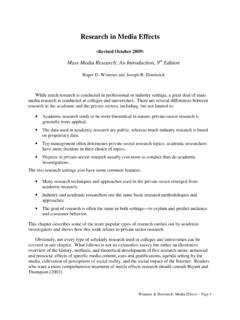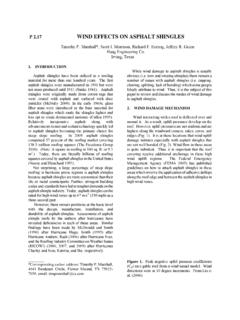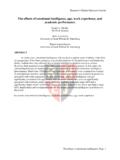Transcription of QSYMIA (phentermine and topiramate extended-release ...
1 HIGHLIGHTS OF prescribing information These highlights do not include all the information needed to use QSYMIA safely and effectively. See full prescribing information for QSYMIA . QSYMIA (phentermine and topiramate extended-release ) capsules, for oral use, CIV Initial Approval: 2012 ----------------------------RECENT MAJOR CHANGES-------------------------- Warnings and Precautions ( )..10/2020 --------------------INDICATIONS AND USAGE------------------------- QSYMIA is a combination of phentermine, a sympathomimetic amine anorectic, and topiramate extended-release , an antiepileptic drug, indicated as an adjunct to a reduced-calorie diet and increased physical activity for chronic weight management in adults with an initial body mass index (BMI) of: 30 kg/m2 or greater (obese) (1) or 27 kg/m2 or greater (overweight) in the presence of at least oneweight-related comorbidity such as hypertension, type 2 diabetesmellitus, or dyslipidemia (1)Limitations of Use: The effect of QSYMIA on cardiovascular morbidity and mortalityhas not been established (1).
2 The safety and effectiveness of QSYMIA in combination with otherproducts intended for weight loss, including prescription and over-the-counter drugs, and herbal preparations, have not beenestablished (1).-----------------DOSAGE AND ADMINISTRATION------------------ Take once daily in morning. Avoid evening dose to preventinsomnia ( ). Recommended dose: QSYMIA mg/23 mg (phentermine 23 mg extended-release ) daily for 14 days; then increase to mg/46 mg daily ( ). Discontinue or escalate dose (as described) if 3% weight loss is notachieved after 12 weeks on mg/46 mg dose ( ). Discontinue QSYMIA if 5% weight loss is not achieved after 12weeks on maximum daily dose of 15 mg/92 mg ( ). Discontinue 15 mg/92 mg dose gradually (as described) to preventpossible seizure ( ). Do not exceed mg/46 mg dose for patients with moderate orsevere renal impairment or patients with moderate hepaticimpairment ( , ).
3 -----------------DOSAGE FORMS AND STRENGTHS---------------- Capsules: (phentermine mg/ topiramate mg extended-release ) mg/23 mg (3 ) mg/46 mg (3) mg/69 mg (3) 15 mg/92 mg (3)------------------------CONTRAINDICAT IONS-------------------------- Pregnancy (4) Glaucoma (4) Hyperthyroidism (4) During or within 14 days of taking monoamine oxidase inhibitors(4 ) Known hypersensitivity or idiosyncrasy to sympathomimeticamines (4)----------------WARNINGS AND PRECAUTIONS--------------------- Embryo-Fetal Toxicity: Can cause fetal harm. Patients who canbecome pregnant: Pregnancy testing recommended before initiatingQsymia and monthly during therapy; advise use of effectivecontraception. QSYMIA is available through a limited programunder a Risk Evaluation and Mitigation Strategy (REMS) ( ). Increase in Heart Rate: Monitor heart rate in all patients, especiallythose with cardiac or cerebrovascular disease ( ).
4 Suicidal Behavior and Ideation: Monitor for depression or suicidalthoughts. Discontinue QSYMIA if symptoms develop ( ). Acute Myopia and Secondary Angle Closure Glaucoma:Discontinue QSYMIA ( ). Mood and Sleep Disorders: Consider dose reduction or withdrawalfor clinically significant or persistent symptoms ( ). Cognitive Impairment: May cause disturbances in attention ormemory. Caution patients about operating automobiles orhazardous machinery when starting treatment ( ). Metabolic Acidosis: Measure electrolytes before/during treatment( ). Elevated Creatinine: Measure creatinine before/during treatment( ). Use of Antidiabetic Medications: Weight loss may causehypoglycemia. Measure serum glucose before/during treatment( ).-----------------------ADVERSE REACTIONS--------------------------- Most common adverse reactions (incidence greater than or equal to 5% and at a rate at least times placebo) are: paraesthesia, dizziness, dysgeusia, insomnia, constipation, and dry mouth ( ).
5 To report SUSPECTED ADVERSE REACTIONS, contact VIVUS, Inc., at 1-888-998-4887 or FDA at 1-800-FDA-1088 or ------------------------DRUG INTERACTIONS--------------------------- Oral contraceptives: Altered exposure may cause irregularbleeding but not increased risk of pregnancy. Advise patients notto discontinue oral contraceptives if spotting occurs ( ). CNS depressants including alcohol: Potentiate CNS depressanteffects. Avoid concomitant use of alcohol ( ). Non-potassium sparing diuretics: May potentiate potassium before/during treatment ( ).------------------USE IN SPECIFIC POPULATIONS------------------ Lactation: Breastfeeding not recommended ( ). Pediatric Use: Safety and effectiveness not established and use notrecommended ( ).See 17 for PATIENT COUNSELING information and Medication Guide Revised: 10/2020 FULL prescribing information .
6 CONTENTS* 1 INDICATIONS AND USAGE 2 DOSAGE AND ADMINISTRATION General Dosing and Administration Dosing in Patients with Renal Impairment Dosing in Patients with Hepatic Impairment 3 DOSAGE FORM AND STRENGTHS 4 CONTRAINDICATIONS 5 WARNINGS AND PRECAUTIONS Embryo-Fetal Toxicity Increase in Heart Rate Suicidal Behavior and Ideation Acute Myopia and Secondary Angle Closure Glaucoma Mood and Sleep Disorders Cognitive Impairment Metabolic Acidosis Elevation in Creatinine Potential Risk of Hypoglycemia in Patients with Type 2 Diabetes Mellitus on Anti-Diabetic Therapy Potential Risk of Hypotension in Patients Treated with Antihypertensive Medications CNS Depression with Concomitant CNS Depressants Including Alcohol Potential Seizures with Abrupt Withdrawal of QSYMIA Patients with Renal Impairment Patients with Hepatic Impairment Kidney Stones Oligohidrosis and Hyperthermia Hypokalemia Monitoring.
7 Laboratory Tests 6 ADVERSE REACTIONS Clinical Trials Experience Postmarketing Experience 7 DRUG INTERACTIONS Monoamine Oxidase Inhibitors Oral Contraceptives CNS Depressants Including Alcohol Non-Potassium Sparing Diuretics Antiepileptic Drugs Carbonic Anhydrase Inhibitors Pioglitazone 8 USE IN SPECIFIC POPULATIONS Pregnancy Lactation Females and Males of Reproductive Potential Pediatric Use Geriatric Use Renal Impairment Hepatic Impairment 9 DRUG ABUSE AND DEPENDENCE Controlled Substance Abuse Dependence 10 OVERDOSAGE 11 DESCRIPTION 12 CLINICAL PHARMACOLOGY Mechanism of Action Pharmacodynamics Pharmacokinetics 13 NONCLINICAL TOXICOLOGY Carcinogenesis, Mutagenesis, Impairment of Fertility 14 CLINICAL STUDIES 16 HOW SUPPLIED/STORAGE AND HANDLING 17 PATIENT COUNSELING information * Sections or subsections omitted from the full prescribinginformation are not listedFULL prescribing information 1 INDICATIONS AND USAGE QSYMIA is indicated as an adjunct to a reduced-calorie diet and increased physical activity for chronic weight management in adult patients with an initial body mass index (BMI) of 30 kg/m2 or greater (obese), or 27 kg/m2 or greater (overweight) in the presence of at least one weight related comorbidity such ashypertension, type 2 diabetes mellitus, or dyslipidemiaLimitations of Use The effect of QSYMIA on cardiovascular morbidity and mortality has not been established.
8 The safety and effectiveness of QSYMIA in combination with other products intended for weight loss,including prescription and over-the-counter drugs and herbal preparations have not been DOSAGE AND ADMINISTRATION General Dosing and Administration Pregnancy testing is recommended before initiating QSYMIA in patients who can become pregnant and monthly during QSYMIA therapy [see Warnings and Precautions ( ) and Use in Specific Populations ( ). Determine the patient s BMI. BMI is calculated by dividing weight (in kilograms) by height (in meters) squared. A BMI conversion chart (Table 1) based on height [inches (in) or centimeters (cm)] and weight [pounds (lb) or kilograms (kg)] is provided below. Table 1. BMI Conversion Chart Weight (lb) 125 130 135 140 145 150 155 160 165 170 175 180 185 190 195 200 205 210 215 220 225 (kg) 56.]
9 859. 161. 463. 665. 968. 270. 572. 775. 077. 379. 581. 884. 186. 488. 690. 993. 295. 597. 7100. 0102. 3 Height (in) (cm) 58 147. 326 27 28 29 30 31 32 34 35 36 37 38 39 40 41 42 43 44 45 46 47 59 149. 925 26 27 28 29 30 31 32 33 34 35 36 37 38 39 40 41 43 44 45 46 60 152. 424 25 26 27 28 29 30 31 32 33 34 35 36 37 38 39 40 41 42 43 44 61 154. 924 25 26 27 27 28 29 30 31 32 33 34 35 36 37 38 39 40 41 42 43 62 157. 523 24 25 26 27 27 28 29 30 31 32 33 34 35 36 37 38 38 39 40 41 63 160. 022 23 24 25 26 27 28 28 29 30 31 32 33 34 35 36 36 37 38 39 40 64 162. 622 22 23 24 25 26 27 28 28 29 30 31 32 33 34 34 35 36 37 38 39 65 165. 121 22 23 23 24 25 26 27 28 28 29 30 31 32 33 33 34 35 36 37 38 66 167. 620 21 22 23 23 24 25 26 27 27 28 29 30 31 32 32 33 34 35 36 36 67 170. 220 20 21 22 23 24 24 25 26 27 27 28 29 30 31 31 32 33 34 35 35 68 172.
10 719 20 21 21 22 23 24 24 25 26 27 27 28 29 30 30 31 32 33 34 34 69 175. 318 19 20 21 21 22 23 24 24 25 26 27 27 28 29 30 30 31 32 33 33 70 177. 818 19 19 20 21 22 22 23 24 24 25 26 27 27 28 29 29 30 31 32 32 71 180. 317 18 19 20 20 21 22 22 23 24 24 25 26 27 27 28 29 29 30 31 31 72 182. 917 18 18 19 20 20 21 22 22 23 24 24 25 26 27 27 28 29 29 30 31 73 185. 417 17 18 19 19 20 20 21 22 22 23 24 24 25 26 26 27 28 28 29 30 74 188. 016 17 17 18 19 19 20 21 21 22 23 23 24 24 25 26 26 27 28 28 29 75 190. 516 16 17 18 18 19 19 20 21 21 22 23 23 24 24 25 26 26 27 28 28 76 193. 015 16 16 17 18 18 19 20 20 21 21 22 23 23 24 24 25 26 26 27 27 In adults with an initial BMI of 30 kg/m2 or greater or 27 kg/m2 or greater when accompanied by weight-related co-morbidities such as hypertension, type 2 diabetes mellitus, or dyslipidemia prescribe QSYMIA as follows: Take QSYMIA once daily in the morning with or without food.
![Sample Appeal Letter [Name of Payer] [Address Re …](/cache/preview/e/6/8/5/b/7/3/d/thumb-e685b73d6344044c7bf20606c28370b9.jpg)







